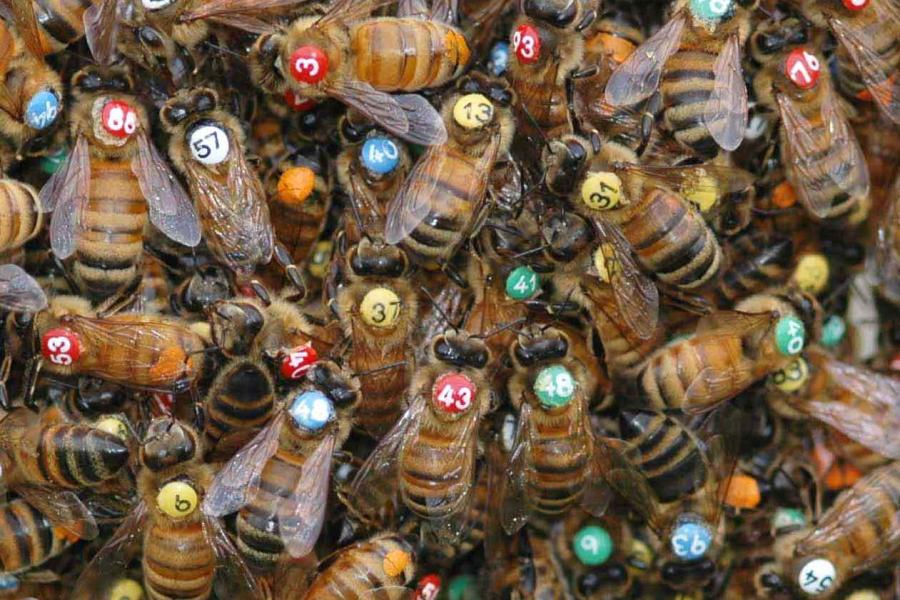Biologist Thomas Seeley has been delving into the mysteries of honey bee behavior ever since he discovered a bee tree as a boy, inspired by reading “Winnie the Pooh” 62 years ago.
In his new book, “Piping Hot Bees & Boisterous Buzz-Runners: 20 Mysteries of Honey Bee Behavior Solved,” he shares some of the findings of his many investigations.
Among them: The insects are humanly relatable. For example, just like us, the worker bees that do hard physical labor (i.e., foraging) need a good night’s sleep to be at their best, and come morning they need wake-up calls (“shaking signals”).
Honey bees, as the primary pollinators for dozens of fruit and vegetable crops that form a core part of our diet, fill a critical niche in our agricultural system. But Seeley’s research has had a surprising impact on an entirely different aspect of human society: our digital ecosystem.
In 2016, Seeley received the Golden Goose Award from the American Association for the Advancement of Science for his discoveries about how the nectar foragers in a colony nimbly – and wisely – allocate themselves among flower patches, despite the locations of the best ones constantly changing. This insight into how honey bees organize their foraging efforts inspired a team of engineers to create the Honey Bee Algorithm, which is now widely used in cloud data centers to allocate servers among jobs.
The College of Arts & Sciences spoke with Seeley, the Horace White Professor in Biology Emeritus (A&S), about his book.
Question: What was your goal in writing this book?
Answer: Almost every book about honey bees has been written from the perspective of beekeeping, so it discusses how to manipulate honey bee colonies to make them good for producing honey and pollinating crops. I chose to discuss instead the behavioral complexity of individual worker honey bees. The take-home message from my book is that these small creatures are extremely intelligent. They may well be the most intelligent of all the insects.

Q: Your experiments often required incredibly painstaking work – for one experiment, you and your team spent 10 hours a day for several days meticulously labeling every worker bee in a colony with an ID tag. Why was it important to you to tell readers about this labeling process?
A: I believe that to fully understand what has been learned from a study, one has to know how the study was conducted. Knowing how an investigation was done helps one assess the strengths and weaknesses of a study’s findings.
Q: You express sincere thanks to Cornell University Library. How did the library help?
A: The Cornell library has enabled me to read the original papers by Karl von Frisch, the great German zoologist, who worked from the 1910s to the 1960s. I like how the old papers in scientific journals are longer and more detailed than recent ones. By having easy access to von Frisch’s papers, I was able to get a clear sense of how he and his students conducted their pathbreaking studies of honey bee behavior.
Q: What have you learned since your 2010 book, “Honeybee Democracy,” about collective decision-making by honey bees?
A: I have learned that a nest-site scout not only performs waggle dances to advertise her potential nest site but also walks up to scout bees advertising other potential nest sites and butts into them while making a beeping sound. Being beeped doesn’t stop the dancing bee cold, but it does create “cross inhibition” between bees advertising different sites. And we know from studies of decision-making in primate brains that cross inhibition helps us make correct decisions. When the differences between alternatives are small, cross inhibition helps us focus our attention most strongly on the best option.

Q: Which of these findings was your favorite?
A: I’m particularly delighted by discovering the meaning of the tremble dance of honey bees. This is a signal that always puzzled von Frisch, who deciphered the honey bee’s waggle dance and received the Nobel Prize for this work.
I discovered that if a nectar forager comes into the hive and has great difficulty finding a bee to receive her load of nectar, then she will produce a tremble dance. Doing so helps her colony solve a nectar delivery problem. If the forager has to spend more than about a minute before starting to get unloaded, she does the tremble dance. It’s a call for more of a colony’s middle-aged bees, who do various jobs, to focus on the task of receiving nectar from foragers.
This story also appeared in the Cornell Chronicle.
Linda B. Glaser is news and media relations manager for the College of Arts & Sciences.





